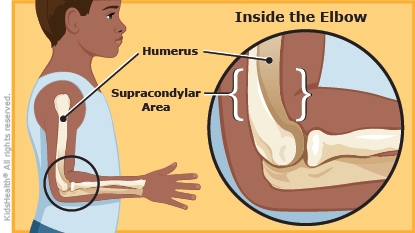A supracondylar (soo-pruh-KON-deh-ler) fracture is a break in the bone right above the elbow. Your child got a cast or splint, along with a sling to support it. If a splint was used, an orthopedic (bone) specialist will replace it with a cast in a few days when the swelling goes down. You can help your child by going to all follow-up visits and taking good care of the cast or splint.

- To reduce swelling in the first 24–48 hours:
- Use pillows to raise the arm above heart level when your child is sitting down or sleeping.
- When your child is awake, put cold packs wrapped in a towel on the cast or splint for 20–30 minutes every 3–4 hours. Don't put ice directly on the cast or splint because it must stay dry.
- For pain:
- Give your child acetaminophen (Tylenol® or a store brand) or ibuprofen (Advil®, Motrin®, or a store brand) as recommended by the care team. Follow the package directions for how much to give and how often.
- If your doctor prescribed a pain medicine but your child still has pain, ask the doctor or pharmacist if it is OK to also give your child acetaminophen or ibuprofen.
Daily cast or splint care:
- Remind your child to wiggle the fingers to keep blood circulating normally.
- Check that the fingers have normal feeling, warmth, and color.
- Check the edges of the cast or splint: Make sure your child isn't picking at or removing the padding from the edges. Make sure the skin near the cast or splint isn't scratched.
- Don't put anything in the cast or splint. Make sure your child doesn't put toys, food, or other objects into it.
- Keep dirt, sand, lotion, and powder away from the cast or splint.
- Your child should use the sling only when up and walking around. Don't let your child wear the sling while sleeping.
- Keep the cast or splint dry:
- No swimming.
- Give sponge baths to kids younger than 5 years old.
- Older kids should take baths instead of showers.
- Put a plastic covering over the arm when your child bathes. Put the arm up on something to keep the cast or splint completely out of the water.
- If the cast or splint is accidentally splashed, gently blow air into it from a hair dryer on the cool setting.
Problems to watch for:
- Sharp edges: Put tape or moleskin (available at drugstores) on any rough spots.
- Itching: Tap lightly on the cast or splint or use a hair dryer on the cool setting to blow air in and around the edges. Don't let your child scratch under the cast or splint or put anything into it.
- Swelling: If the fingers look puffy, raise the arm above the level of the heart for 1 hour. If the swelling doesn't get better, call your health care provider.
Be sure to:
- Schedule a follow-up visit with the orthopedic specialist as recommended.
- Have your child avoid gym class, sports, and playground equipment and activities until the orthopedic specialist says it's OK.

Your child's fingers tingle or become numb, blue, or pale.

Which bone is broken? The supracondylar area is part of the humerus bone, which is between the shoulder and the elbow.
How do supracondylar fractures happen? This type of fracture can happen when kids hold out their arm to try to stop a fall or fall directly onto the elbow. The supracondylar area is thinner than the rest of the bone, so it is more likely to break.
How long will my child have a cast? Healing time varies, but a cast usually is worn for 3–4 weeks.




